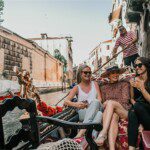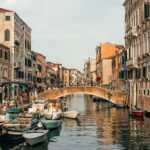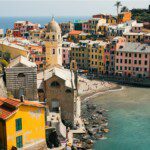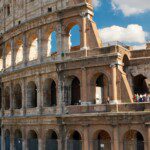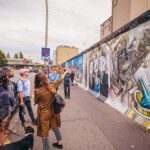Berlin to Rome
Embark on a true Eastern European escapade on this 22-day adventure from Berlin to Rome. With plenty of free time in each spot and a local leader providing recommendations along the way, you’ll get immersed in the buzz of Berlin, the beauty of Prague and the bustle of Budapest. Tour the grand summer palace in Vienna, step into a fairytale in Salzburg’s Old Town and walk through the enchanting Vintgar Gorge in Bled. Finish with the canals and clifftop villages of Venice and Cinque Terre, and the piazzas of Rome – this is an adventure you truly won’t want to miss.
22 days, from
$5,330
per person
GROUP SIZE
ACTIVITY LEVEL
Details
Countries Visited:
Austria
Czech Republic
Germany
Hungary
Italy
Poland
Slovenia
Accommodation: Hostel (5 nights), Hotel (14 nights), Guesthouse (2 nights)
Transportation: Metro, Private vehicle, Public bus, Taxi, Train
Included Meals:
- 12 breakfasts
Group size: Minimum 1, Max 16
Minimum Age: 15
Begin and end in cities known for their complex pasts and influential art movements, albeit in very different ways – Berlin and Rome.
Step back in time as you wander Krakow’s World Heritage-listed Old Town and the 13th-century town square of Rynek Glowny.
Relax on the peaceful shores of Lake Bled in Slovenia. Maybe visit the tiny island church on the lake or treat yourself to a slice of Bled's famous cream cake.
Walk along Cinque Terre's rocky coastal pathways, calling into the sleepy pastel villages of Manarola, Riomaggiore and Vernazza.
Explore Rome’s instantly recognizable landmarks like the Colosseum, the Sistine Chapel and St Peter's Basilica – no less impressive for their notoriety.
Itinerary
Guten Tag! Welcome to Germany. Your adventure begins with a welcome meeting at 6 pm. There are no activities planned until this important meeting, so feel free to arrive at any time during the day. There are many significant memorials and historical sites dotted around Berlin including the Jewish Memorial, the empty shelves of Bebelplatz and the confronting Topography of Terror – some of which you may like to visit this afternoon. Tonight, after your welcome meeting, why not join your newfound travel pals for dinner. Berlin’s food is a mix of classic German with Bavarian, Italian and Middle Eastern influences. But who can go past a traditional currywurst, schnitzel or pretzel together with a stein of beer?
This morning, say goodbye to Germany and hop on a train to Wroclaw, Poland. Wroclaw is the cultural centre of southwest Poland, sitting on the banks of River Oder for over 1000 years and shaped by influences of Czech, German and Polish rule. Arrive in the early afternoon and settle into your hotel, then follow your leader on an orientation walk around this city that makes it feel as though you’ve stepped back in time. The rest of the day is free for your own discoveries. You may like to check out Ostrów Tumski (Cathedral Island), the Old Town Square and the Four Denominations District, where the city’s incredible architecture and history is on full display. Don’t miss out on appreciating Wroclaw from River Oder or experiencing the vibrant cultural scene – your leader will be on hand to give recommendations on local hotspots.
This morning, board a train bound for Krakow, your base for the next two nights. Upon arrival, follow your leader on an orientation walk. Wander the World Heritage-listed Old Town, perhaps stopping to shop for amber jewellery or local crafts in the stores. Discover Wawel Royal Castle which sits atop a hill next to the Vistula River. Check out the 13th-century town square of Rynek Glowny and get a glimpse of the impressive St Mary's Basilica. Another beautiful church is the Neo-Gothic St Francis' Basilica, which boasts some of Poland's best Art Nouveau interiors. This city is also home to the second-oldest university in Central Europe, Jagiellonian University. Among many (many) others, it counts Copernicus and Pope John Paul II among its alumni.
If you can tear yourself away from Krakow on your free day, why not head out to the Wieliczka Salt Mines, a network of tunnels and chambers some 135 metres below the ground. This is a salt mine that has been in operation for over 700 years. The mine has a labyrinth of tunnels, pits and chambers, all hewn by hand from solid salt, with beautifully adorned chapels and underground lakes. Don't miss a look at the elaborate salt chandeliers and carvings in the Blessed Kinga Chapel. Alternatively, you might like to take a sobering day trip out to Auschwitz and Birkenau, the sites of some of the Holocaust's worst atrocities. Perhaps end the day in one of Krakow's many cellar restaurants for a plate of pierogi and a drink.
Take a minivan to the town of Ostrava, then board the train to Prague. After arrival and check-in at your hotel, you’ll see the highlights of this beautiful city on a leader-led orientation walk. Prague's architecture can be traced from the Middle Ages through to the avant-garde of the Gehry-designed Dancing Building (also called the Fred and Ginger Building). Spend your free afternoon at Prague Castle – the biggest in the Czech Republic – where you'll find the famous St Vitus Cathedral and Golden Lane. Continue on to wander through the old Jewish Quarter to see what remains of the city's formerly significant Jewish community.
Another day in Prague and so many possibilities. Perhaps learn how the Bohemian artists, writers, dissidents, and the Bohemian mentality shaped the nation. Don’t forget to sample some of the best Czech beers and traditional and modern Czech snacks along the way. If you feel like going for a day trip out of the city, ask your leader to help you organise a trip to Kutna Hora. See the Church of Santa Barbara and Sedlec ossuary or The Church of Bones – a small Roman Catholic chapel that contain the skeletons of between 40,000 and 70,000 people. At night, Prague’s Old Town comes alive with many great restaurants and pubs, some in old vaulted cellars. The nightlife in Prague is some of the best in Central Europe. Whether you're after dance clubs, beer-halls, jazz clubs or underground absinthe bars, there's something for everyone.
Leave Prague and travel by bus to Cesky Krumlov. This picturesque medieval town dates back to the 13th century and appears to be plucked straight out of a fairytale. Wander the cobbled alleyways of the Old Town and admire the buildings. A great way to discover the town is to join a tour guided by a local – you will learn about the architectural symbolism and Old Town mysteries from an expert. Climb up to the castle perched on a hill and check out its fabulous Masquerade Hall and admire the sensational views that can be seen from the tower. Weather and time permitting, your group may take a relaxing two-to-three-hour rafting or canoeing trip along the river which runs right through town.
Hop on your private transfer to the cosmopolitan city of Vienna. After arrival, your leader will help you get your bearings by showing you the city centre on foot, and then you’ll have a free afternoon to explore the city. Art lovers will be delighted by the vast array of museums on offer, including the Albertina, the Leopold, Kunsthalle Wien and the Museum of Modern Art. Those with an interest in 19th- and 20th-century Austrian art should visit the Belvedere Palace, home to Gustav Klimt's painting 'The Kiss'. Check out the colourful Hundertwasserhaus or admire the dome of the Secession building. Perhaps visit Hofburg Palace – once the imposing winter retreat of Habsburg royals and now the official residence of the Austrian president. No visit to Vienna is complete without attending an opera or concert. Check out well in advance what Vienna State Opera House has on offer and immerse yourself in the city’s musical pedigree.
A free day in Vienna will give you more time to visit places you didn’t manage to get to yesterday. Climb the tower of St Stephen's Cathedral, take a spin on the Prater Ferris Wheel or catch a dressage show at the Spanish Riding School. Head to the elegant Schoenbrunn Palace, which was designed by the empress Maria Theresa. After all this sightseeing, you might like to indulge in a traditional Viennese coffee and sachertorte this afternoon – a pastime fit for the most sophisticated of travellers.
Today, you'll travel from Vienna to Budapest by train. Budapest's grand architecture and boulevards evoke a bygone era, and your leader will introduce you to the stunning city by taking you on an orientation walk. Explore one of the local markets, where you'll be lucky enough to pick up a langos - a delectable deep-fried Hungarian pastry with an assortment of different toppings. Then later, with so much to see and do in your free time, why not head out to Statue Park to get an insight into the city’s past or take a soak in one of the many thermal bath complexes around town. The baths feature pools of varying temperatures, and some even have whirlpools or built-in seats where you can relax or play a game of chess. Tonight, get a group of friends together for a Hungarian feast – a hearty bowl of goulash or another decadent pizza-like langos is waiting. Afterwards, why not stroll to the Jewish quarter and check out some ruin bars: unique nightlife hubs that are great for groups and feature a whole heap of weird and wonderful decor.
Enjoy a free day in the self-proclaimed Pearl of the Danube. Perhaps explore the historical Buda Castle and palace complex. Forget about the bustling city and lose yourself in the history of the winding streets of the Castle District, which dates back to the 13th century. In the afternoon, you could take a slow cruise along the Danube for some pretty epic views of the riverside Parliament Building, the Castle District and the bridges linking Buda to Pest. The spectacle is particularly beautiful, especially at sunset and at night.
Buckle up for a solid day of travel into Slovenia. Take a train to Ljubljana, followed by a connecting bus to the town of Bled, situated at the edge of the Julian Alps. Arrive in the late afternoon and follow your leader to the shore of beautiful Lake Bled, from which many of the town’s attractions can be seen and explored. For a taste of the local cuisine, some Bled cake made of vanilla, custard, cream and pastry is essential. After settling into your accommodation tonight, why not get together with your group for dinner, feasting on local specialities.
There’s no better places to get active than in Bled! Today you have a free day to go for a walk along the lake in the morning, and perhaps enjoy a full-day adventure around Triglav Massive. There are many outdoor activities available here to get the blood pumping, such as rafting, caving, canoeing and swimming. Why not hire a bike and head four kilometres out of town to Vintgar Gorge, where you can take a walk through a beautiful natural canyon. Perhaps explore Bled Castle, perched atop the cliff overlooking the lake, or catch a pletna (small wooden boat) over to the island in the middle of the lake to ring the wishing bell. Your group leader will have all the options, so be sure to chat with them for their recommendations and how to book any optional activities. If you’d prefer to have a relaxing day and just enjoy the beauty of Lake Bled, find a quiet spot near the lake and spend the day reading a book.
Travel by train and local bus through stunning scenery to one of the world's most unique cities, Venice. A city of canals, Venice is built over a hundred small islands connected by 400 bridges. On arrival, head out for an orientation walk with your tour leader – the best way to see Venice is by foot – passing by the Grand Canal, Rialto Bridge, Palace of the Doge, Piazza San Marco and the Bridge of Sighs. Wander the cobblestone streets and spacious piazzas, crossing bridges and stopping for a gelato on your way, if you’d like. There are shops, markets, galleries and churches around every corner. After a pretty jam-packed few days, why not gather with your travel pals and celebrate being in Italy with a meal?
Enjoy free time in this watery wonderland of bridges, towers, piazzas, canals, churches and gondolas – practically unchanged for 600 years. Rich with artistic masterpieces, modern Venice combines history with contemporary life through food, performance, art and architecture. Take a walk around the maze of streets behind San Marco square and begin to understand the complex canal system of Venice.
Today you are free to explore Venice at your own pace. There are only two ways to get around this city – on foot or by boat. Some of the more popular sights include Doge's Palace, the Piazza and Basilica di San Marco and the Bridge of Sighs. Maybe take the vaporetto (water bus) over to the island of San Giorgio to climb the bell tower for views over the city. Or perhaps fulfil a bucket list favourite and take journey down the Grand Canal in a Venetian gondola. It really is the perfect way for visitors to see the major canal routes from an immersive perspective. Regroup for a snack at a local restaurant that provides employment, support and advocacy to Venice’s migrant and refugee community – the menu is inspired by the journeys they took to get to Europe. The rest of the day is yours – Venice is famous for its specialities of fresh lobster and squid ink spaghetti dishes, so perhaps give one of them a try this evening.
Board a morning train through the scenic north of Italy to the once important naval base of La Spezia (approximately 6–7 hours). La Spezia is known mainly as the gateway to the gorgeous Cinque Terre (Five Lands). The name comes from the five tiny villages – Monterosso, Vernazza, Corniglia, Manarola and Riomaggiore – positioned on a series of coves between sheer cliffs. On arrival in La Spezia there won't be too much time to explore (that’s what tomorrow is for), but after checking into your hotel perhaps get your bearings with a short walk around the pedestrian zone on Via del Prione or head out for dinner with the group.
Spend today exploring winding footpaths and pastel coloured villages with your included Cinque Terre Pass. Your leader will walk you to two of the five villages, and the pass gives you access to the paths and trains of the area for 24 hours. Please consult your leader on which walking section is right for you, as some have challenging uphill stretches, narrow paths, steep cliffs and foot bridges. Alternatively, take the train between any of the villages, or back to the group's base in La Spezia whenever you want. After working up an appetite, maybe take advantage of an optional pesto class. Focaccia is also a speciality in this area and makes a great start to lunch, if you’d prefer.
Depart La Spezia today and catch a train to Florence (approximately 3.5 hours). On arrival, check into the hostel and go for a brief walk around the immediate area to get your bearings. Florence is one of the most culturally rich and beautiful cities in Italy, known to many as the beating heart of Tuscany. The Medicis, Leonardo da Vinci, Raphael, Brunelleschi, Machiavelli, Donatello and Michelangelo all lived in Florence at the height of their creative reign. Food is a major part of the city's identity and the optional activities on offer reflect this. Maybe explore the city’s culinary history (and taste some local treats) on a Florence Foodies Walk with Urban Adventures. Carnivores might be drawn to try the Bistecca alla Fiorentina, the Florentine Beef Steak, essentially a huge T-bone steak that comes with classic sides.
Enjoy another day in beautiful Florence. It's impossible to see everything in this Renaissance wonderland, so the best idea is to relax and pick a few things you really want to do. Maybe start with a visit to the Galleria dell'Accademia where you can see Michelangelo's famous statue of David, or perhaps stop by the Uffizi, one of the world's oldest art galleries. Active types might want to walk up to Piazzale Michelangelo, which is set on a hill on the south bank of the Arno River, to take in beautiful views of the city – a lovely way to while away the day. There are plenty of optional activities on offer during your time here, so be sure to grill your leader for the details on each so you can get a sense of what interests you.
Take the morning train to Rome (approximately 2 hours). Join your leader on an orientation walk around the city to see icons such as the Colosseum and Arch of Constantine, the Forum (centre of ancient Rome), the Victor Emmanuel Monument, the Pantheon, the Spanish Steps, Via Dei Condotti and Piazza Venezia. Phew. After all that history it’s probably time for lunch. Maybe grab a slice of the good stuff and a strong espresso at the Piazza Navona. You can spend your afternoon how you wish and there are plenty of heavy hitters to choose from. Maybe enter the Vatican and check out St Peter's Basilica. Art lovers could visit the Sistine Chapel to admire the timeless work of Michelangelo, while history buffs may enjoy a jaunt through the ancient halls of the Pantheon. Rome is packed full of trattorias that cater to every taste and budget, so this evening maybe link up with the group for dinner.
Your adventures come to an end today. There are no activities planned and you're free to depart the accommodation at any time after check-out. As there is so much to see in Rome, we recommend you stay a little longer to soak it up. We are happy to book additional accommodation for you (subject to availability). Please speak to an agent at the time of booking.


